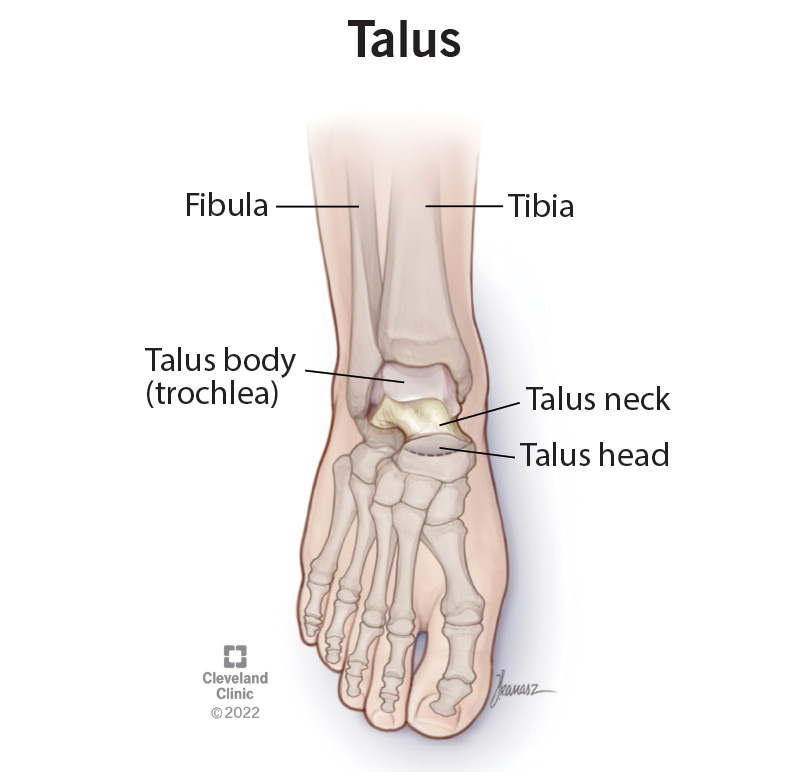Even though it’s a small bone, the talus plays a big role in your ability to stand and move. It supports your weight and helps your ankle move smoothly. Injuries and damage to the talus can take longer to heal and have a higher risk of complications than other bones.
Advertisement
Cleveland Clinic is a non-profit academic medical center. Advertising on our site helps support our mission. We do not endorse non-Cleveland Clinic products or services. Policy

The talus bone is a small bone in your ankle. It’s sometimes called the astragalus bone.
Advertisement
Cleveland Clinic is a non-profit academic medical center. Advertising on our site helps support our mission. We do not endorse non-Cleveland Clinic products or services. Policy
The talus is the second biggest bone in the back of your foot (your hindfoot). Only the calcaneus (heel) bone is bigger.
The talus meets your tibia (shin bone) and fibula (calf bone) to form your ankle joint.
If you experience a fractured (broken) talus, you might need surgery to repair your bone and physical therapy to help you regain your strength and ability to move.
Your talus — like all bones — can be affected by osteoporosis.
Your talus has several important jobs, including:
The talus is in your ankle, toward the back of your foot. It’s the point where the two bones in your lower leg — your tibia and fibula — meet your foot.
The talus is shaped like a saddle. It has two flared lower ends and a domed ridge in the middle. It’s covered in a layer of cartilage that acts like a cushion, shock absorber and lubricant to help your ankle move smoothly.
Unlike lots of other bones, the talus isn’t connected to any muscles.
The talus has three parts:
Advertisement
These parts and labels are usually more for your healthcare provider to use as they describe where you’re having pain or issues. If you ever break your talus — a talus fracture — your provider might use some of these terms to describe where your bone was damaged.
The talus is small. Most adults’ talus bones are around 2 inches long.
The most common issues that affect the talus are fractures and osteoporosis.
A bone fracture is the medical term for breaking a bone. You can break your talus in a trauma like a fall or car accident. Some people also experience talus fractures playing sports. Symptoms of a fracture include:
Go to the emergency room right away if you’ve experienced a trauma or think you have a fracture.
Osteoporosis weakens bones, making them more susceptible to sudden and unexpected fractures. Many people don’t know they have osteoporosis until after it causes them to break a bone. There usually aren’t obvious symptoms.
Females and those older than 50 have an increased risk for developing osteoporosis. Talk to your provider about a bone density screening that can catch osteoporosis before it causes a fracture.
Other common issues that can affect your talus include:
The most common test done to check the health of your bones is a bone density test. It’s sometimes called a DEXA or DXA scan. A bone density test measures how strong your bones are with low levels of X-rays. It’s a way to measure bone loss as you age.
If you’ve experienced an injury, your provider or surgeon might need imaging tests, including:
Usually, your talus won’t need treatment unless you’ve experienced a fracture or other injury to your ankle. You might need treatment if you’ve been diagnosed with osteoporosis.
How your fracture is treated depends on which type it is and what caused it. You’ll need some form of immobilization — like a splint or cast — and might need surgery to realign (set) your bone to its correct position and secure it in place so it can heal.
Treatments for osteoporosis can include exercise, vitamin and mineral supplements and medications.
Exercise and taking supplements are usually all you’ll need to prevent osteoporosis. Your provider will help you develop a treatment plan that’s customized for you and your bone health.
Advertisement
Following a good diet and exercise plan and seeing your healthcare provider for regular checkups will help you maintain your bone (and overall) health. If you’re older than 50 or have a family history of osteoporosis, talk to your provider about a bone density scan.
Follow these general safety tips to reduce your risk of an injury:
The talus is a small bone that plays a big role in your ability to walk, stand and move. It can take longer to heal and has a higher risk of complications than other bones, so visit your provider as soon as you notice any pain or other symptoms in your ankle. Go to the emergency room right away if you’ve experienced a trauma.
Talk to your provider about your osteoporosis risk, and ask them about ways you can support your bones as you age.
Advertisement
From sudden injuries to chronic conditions, Cleveland Clinic’s orthopaedic providers can guide you through testing, treatment and beyond.

Last reviewed on 07/05/2022.
Learn more about the Health Library and our editorial process.